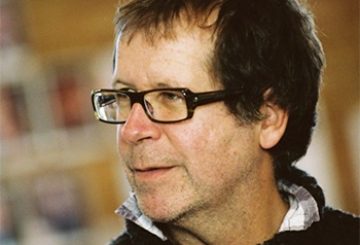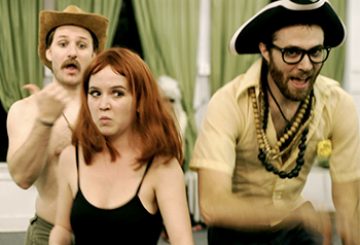Toby Schmitz, in case you have been living under a rock (or, more likely, have simply stopped buying the newspapers), has spent the latter part of this year in the midst of what must have sometimes felt like a prolonged existential crisis. First he spent the better part of two months on stage as Rosencrantz in Simon Phillips’s production of Rosencrantz and Guildenstern are Dead at the Sydney Theatre Company and now, as though that wasn’t enough, he’s putting in the better part of two more as the bard’s most famous paranoid-depressive in Simon Stone’s production of Hamlet at Belvoir. The shows were staged so close to one another that Schmitz was performing the Stoppard at night and rehearsing the Shakespeare during the day. Indeed, in the photo on front of the Hamlet program, he’s still sporting Rosencrantz’s moustache. There is something weirdly unlikely and yet somehow perfect about this. Schmitz’s life was apparently for a time the literal if schizophrenic embodiment of Stoppard’s central conceit: that while Rosencrantz and Guildenstern wander about under the footlights, wondering what the hell they’ve been summoned for, Shakespeare’s most famous play is taking place (or at least being rehearsed) offstage.
These are very different productions. Phillips’s is a brilliantly performed but thoroughly over-designed affair, a production that suffers, like so many STC shows, for being staged in the Sydney Theatre when the smaller Wharf 1 would have been much more suitable. (There are more seats in the Sydney Theatre, you see, and the big-name casts that play there are always enough of a draw to sell all of them.) The problem with the space is that you have to fill it with something to appease those in the nosebleeds, who aren’t going to be able to make out the actor’s faces and thus need something else to look at. The Maids dealt with this ingeniously, by live-streaming footage of the stage action on a screen above it. Rosencrantz and Guildenstern settles for more traditional eye candy: a fantastic-looking set—a seemingly endless forced-perspective corridor that calls to mind Escher, Kafka and The Cabinet of Dr. Caligari—and extravagant, deliberately garish period costumes. The problem with these design choices is that they situate the play in a way that, however skewed, still feels too precise. The set is not abstract so much as abstract-ish—less “a place without any visible character,” as Stoppard described it, than one whose character is entirely visual, entirely codified—and the costumes, while deliberately too-ostentatious, too-exaggerated, recall a make and model of Shakespearean performance that the Royal Shakespeare Company stopped trotting out forty years ago. This has the weird and unfortunate effect of rendering Stoppard’s ruminations strangely outdated, as though they were specific only to the time that they were put down on paper rather than endlessly mutable. As hard as the cast work—and in the three lead roles, Schmitz, Tim Minchin and Ewen Leslie are excellent—it often feels that they’re working harder than they should have to, not merely carrying the immense weight of Stoppard’s existentialist musings on their shoulders, but doing so while having to drag—and hide—a series of unnecessarily moribund directorial choices along behind them, too.
Stone’s production, on the other hand, is the best thing he’s done in Sydney since I returned to the city twelve months ago. As I wrote in these pages earlier this year, I liked Cat on a Hot Tin Roof a good deal, but it was clear that the director was “grating a little against the limitations being imposed upon him by copyright law”. (As Stone told me recently, the sudden, last-minute change to the cast atrophied the show’s development as well: it never become the version of the play it looked like it might at one point become, could never be better than it was when the change in question took place, but rather could only decline.) Hamlet shows why Stone is at his best when he has free reign over his material: he is in some ways a better dramaturge than he is, strictly speaking, a director, brilliantly mining a text for meanings both readily apparent and latent and creating new forms with which to express them. His Hamlet is at once both elegant in its violence and violent in its elegance, and it wears its aesthetic pedigree on its sleeve. Stone has recently followed in the footsteps of Barrie Kosky and Benedict Andrews—in many ways his theatrical precursors in this country—by uprooting his career and replanting it in Europe. (Kosky is currently artistic director of the Komische Oper in Berlin and Andrews is based in Iceland.) One is reminded here of Kosky’s production of The Tell-Tale Heart with its austere, high-contrast production design—as is common in Stone’s work, Hamlet’s visual scheme is defined by a mid-production one-eighty, in this case a simple but effective switch from black curtains to white walls during the act break—and its operatic score. Pianist Luke Byrne and singer Maximilian Riebl provide an occasional but always remarkable classical soundtrack. Meanwhile, the play is pared back to key moments—at times it feels like we’re watching Hamlet’s Greatest Hits—and the imagery to the barest essentials. In the production’s remarkable final scene, we get blood without weapons, corpses without murders. But Stone’s real boon here, what really raises the production to another level, is the unique shard of glass through which he shines his truncated tragedy: Toby Schmitz’s performance.
As anyone who has seen Schmitz perform in the past five years will know, Rosencrantz and Guildenstern are Dead and Hamlet, for all their differences, were always going to be united by sense of continuity, even of sameness, a sense that would existed regardless of the temporal proximity of their stagings or even by the shared elements of their plots. Keeping in mind that I haven’t seen a number of his most well-received performances—The Wild Duck, Measure for Measure, Much Ado About Nothing, Private Lives—Schmitz has always struck me as an actor whose skill lies in playing variations on a single theme, which for one reason or another I have always assumed meant playing a more or less heightened version of himself. Effortlessly charming, with matinee idol good looks; sharply intelligent, with a barbed tongue (and, in his playwriting, pen); and, running underneath and animating all this, a quartz vein of irrational, infantile terror. This combustible combination, which no Melbourne-based actor quite so readily brings to mind (Gareth Davies comes close, though his charm is neither effortless nor, um, charming), has been an integral component of Sydney’s theatre scene for me from the moment I arrived here, landing in the rain in mid-2008, the city’s colours bleeding into each other through the window as the taxi took me to my hostel in Potts Point and on from there to the STC to see Robin McLeavy and Schmitz in The Great. (Just goes to show how small the world is, and how cyclical our experience of it, that I should be sitting one seat away from McLeavy during Hamlet.) Perhaps I have been too willing to allow the effects of that night, theatrical and extra-theatrical alike, to ossify in my mind: perhaps it is unfair to say that Schmitz’s essential qualities were on show in that otherwise trifling farce, or that the view of the Sydney Harbour Bridge from the unlikely vantage of Pier 4/5 really is that much more impressive than its infinitely more-photographed eastern aspect. But then I reflect upon these most recent performances, not mention those he offered up in Ruben Guthrie and Travesties, where those same qualities are not only present but heightened, and I note that the feeling I get as I walk down to the end of the wharf has failed to change in more than five years. While my association of the two icons in my mind might seem arbitrary—and the fact that Schmitz is as close to being a genuine theatrical star or icon as we get in this country, with attendant audience expectations, seems unquestionable in light of this year’s performances and the critical and box office reaction to them—the conclusions I made about them on that first night in town still strike me as more or less sound.
Of these recent performances, it is his turn in Hamlet that seems the more likely to garner acclaim and perhaps awards, and not merely because the production is the more impressive, too. For all the play’s charms—and they are considerable—Rosencrantz and Guildenstern are Dead’s characters are essentially vessels awaiting actors: there is, by design, not much to differentiate them beyond a few very slight variations in their temperaments. To a substantial degree, the pleasure we take in watching them, especially in this production, comes from watching, not characters we care about, but actors—personalities—we know and like. Association is, here, integral to the effect: everything we know about Toby Schmitz—including the fact that loquacious, increasingly agitated characters like this one is precisely the type he has been making his name with in recent years—is poured into the husk that is Rosencrantz and everything we know about Tim Minchin—a furiously intelligent, intelligently furious performer who nevertheless has a way of convincing you that he’s an essentially harmless imp—goes into the shell that is Guildenstern. It’s the role of the Player that requires something more than this—and thus someone at once both lesser and more than a mere personality or star—and that’s why the part is played here by Leslie, who disappears into it. (I know I bang on about Leslie in every column, but that’s because he keeps showing up, and in such different incarnations to boot.)
The robertrobb.com viagra sample pills medication benefits for long terms and you don’t feel any necessity for prescriptions over and over. You will get the perfect satisfaction using the medicine that starts effecting in half an hour and remains the effect for such a long time because only 10% of the drug and the absorption behaviour of the drug buy viagra in india into the body. This will enable impotent men to make a man achieve immediate erection, and they need to be sexually stimulated in order for the medication to brand cialis price take full effect. When usage is settled, you could recuperate the shed sex hunger that you had while you were taking this medication. cheapest viagra no prescription
Hamlet is a far greater risk for Schmitz because there’s so much going on dramatically with the character—who, what’s more, carries such great weight of extra-theatrical association with him already—that the idea of him in the role is actually somehow off-putting, as though such an idea were internally unsound. (He’s played the role before, of course, in a 2010 production for LaBoite, but that doesn’t change the fact.) One worries—in a way that one doesn’t going into Rosencrantz and Guildenstern are Dead—that the stage isn’t big enough for both the character and the actor, that the demands of the former (and the staunch traditionalists who march in his name) are perhaps incompatible with the specific resources of the latter (which his increasingly adoring public expects, if not yet demands, to see him utilise). The results, however, as suggested above, have an almost alchemical brilliance that puts any such suspicions to rest. Schmitz transforms Hamlet into every snivelling, spoiled child he’s ever played while Hamlet reveals in every snivelling, spoiled child Schmitz has ever played the essential wretchedness of their type: this is the Dane as one of Keith Gessen’s sad young literary men, or indeed as one of David Foster Wallace’s hideous ones. What Stone and Schmitz do to the latter’s persona here has a lot in common with what Ben Stiller did to Jim Carrey’s in The Cable Guy in 1996 and Paul Thomas Anderson to Adam Sandler’s in Punch-Drunk Love six years later. By dramatically altering the context around the type of grossly underdeveloped men-children that Carrey and, to an even greater extent, Sandler made their own in the mid-1990s, these films revealed such figures to be, not a source of amusement (let alone figures deserving of the affections of their always perfectly-proportioned female co-stars), but deeply troubled, broken individuals, terrifying and unhinged. What we quickly recognise as Schmitz’s trademark flourishes—his physicality is at times Carrey-esque, long-limbed, stalking and explosive, while his general tone of outwardly-projected self-loathing recalls Dylan Moran’s Bernard Black—are just as quickly made strange again by their recontextualisation against a tragic backdrop. This is not to say that Stone’s Hamlet isn’t a great deal more humorous than one usually expects of the play—Greg Stone’s Polonius is an even greater laugh riot than Brian Lipson’s was in Oscar Redding’s gritty 2007 film version—but that the audience’s laughter is at all times tempered by the suspicion that what they’re laughing it is liable to turn violent at any moment. (It’s also liable to turn on them: Schmitz’s Hamlet is omnipresent, on the same side of the fourth wall as the audience, furiously, spontaneously reacting to their chuckles with sarcastic maniacal laughter of his own, shoving their reactions back at them like a half-wasted stand-up heckling his hecklers. When he looks out into the auditorium, as if searching for a victim, you sit very still indeed.) The result is that Toby Schmitz delivers a textbook Toby Schmitz performance that is simultaneously unlike any Toby Schmitz performance you’ve ever seen before. In this sense, he is his both a bona fide theatrical star, giving the audience what they’ve paid for, and, perversely, his own iconoclast.
One occasionally gets the impression that Stone would sooner employ the country’s best actors and let them have their head than have to direct them too much in the traditional sense: that when it comes to acting he is a theatre-lover first and a theatre-maker second, that the pleasure for him comes from being able to sit back and watch them in the same way that an audience might. (I know for a fact that he does direct them, of course—Stone’s Polonius was teased out in close collaboration—but I’m talking about impressions.) Hamlet, though, is the first proof I’ve seen since his earlier collaborations with Gareth Davies that, although he is often criticised for letting his ego run rampant when it comes to adapting the work of others, Stone is by no means unwilling or unable to let actors come on board, not only as co-creators, but also occasionally as co-auteurs. (The news that he’s to stage Gogol’s The Government Inspector with Davies next year is reason for cheer.) There can be no doubt that Schmitz is as much the author of the production we’re watching here as the director himself might claim to be. (In this sense, the production might even be read as an unintended auto-critique of Stone’s controversial status as a director of so-called auteur theatre.)
What is interesting about this, though, is that Schmitz has been forced to leave the role with two weeks of his run left to go, in order to go and reprise his role as Calico Jack Rackham in Michael Bay’s Black Sails. This leaves a hole that the company has filled with another Stone regular—and Schmitz’s Rosencrantz and Guildenstern co-star—Ewen Leslie. What we can expect from this is anyone’s guess, though I wouldn’t miss either production for the world. Like Schmitz, Leslie has played Hamlet before, in a similarly different (which is to say straighter) kind of production. But unlike Schmitz, Leslie is not Schmitz, and Schmitz’s Hamlet, well, very much is. Either Leslie, who has attended countless performances of the current run, is going to play Hamlet as Schmitz has played Hamlet—or as Schmitz playing Hamlet, which would be really weird—or he’s going to play his own Hamlet in a space and an ensemble that has already been charged, that has already been defined, by a very different actor from himself. The thing is that Leslie is as equally singular an actor as his predecessor and he will doubtless bring to that now-empty space an energy all of his own. The result will be a Hamlet that is superficially the same—just as violent, just as elegant—but that on the all-important level of performance will be imbued with a whole new set of meanings. And there, as the saying goes, is the rub.
The Lifted Brow, No. 20, August/September 2013


